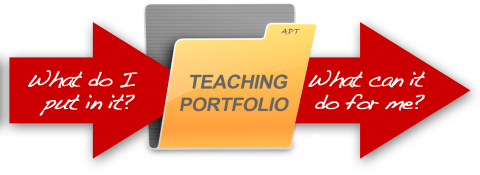Teaching Portfolios

A cohesive collection of documents that communicates your philosophy of teaching, summarizes your teaching activity, provides evidence of your effectiveness, highlights student mentorship, and demonstrates a commitment to professional development.
Teaching portfolios are now required for all faculty wishing to be considered for promotion.
What goes into my portfolio? Portfolios vary and there is no single structure for them, as their contents and formats are different for disciplines and academic units. The first step is to consult with colleagues and mentors to inquire whether there is existing guidance or a template that might be relevant. Next, spend a few minutes searching online to get an idea of how others in your field have approached their portfolios (and the diversity of styles and formats). Given that there is no right answer, we offer one possible approach to organizing your own portfolio, and at the bottom of this page you will see how you can get help preparing yours.
- A title page with the appropriate biographical details and a table of contents.
- Your teaching philosophy statement - Generally a one to two page narrative of your perspective on teaching.
- A teaching activity summary document (template) that provides an overview of the courses you have taught or supported. The data you will need to create a chart like this is now available online.
- A course summary page (template) for each one that provides a clear overview of the learning goals, coursework, and assessments with links to relevant documents included as appendices.
- An overview of the ways in which you have mentored graduate and/or undergraduate students (template), whether through formal assistantships and supervision or more informal consultations and collaborations.
- A summary of the professional development activities in which you have participated, such as peer observations, workshops, consultations with the TLTC, fellowships, or teaching-related conferences. You might also include contributions toward the development of others and any awards or recognition that you have received.
- An overview of what you believe is the most compelling evidence that you have been effective. Include links to complete documents as appropriate or required. There are many different sources of evidence that you might summarize. Here are a few:
- Trends in specific aspects of the campus' standard course evaluation surveys. This might include graphs of numeric scores, representative quotes included by students, even evidence of change over time in a particular aspect of your teaching. It can also be helpful to provide some context for why you believe students responded as they did and what you have done to address constructive criticism.
- Summaries of your own evaluations. Many faculty administer their own pre-, mid-, and post-semester surveys to collect feedback on more specific aspects of the course and the student experience.
- Peer observations, often in the form of a narrative written by the observer, can also speak to the ways in which others find your course design and execution to be particularly effective. This also gives you the opportunity to address identified areas for improvement and what you have done since receiving the feedback. The TLTC and the Office of Faculty Affairs have developed some guidance on conducting peer observations (PDF / Word) that might be helpful.
- Learning outcome assessments are more formal evaluations of student learning, often done in conjunction with departmental reviews or with courses carrying General Education designations.
- Examples of your students' work can also be a compelling way to demonstrate their learning. You might summarize how their work reflects your course goals and then link to actual examples of deliverables or performances that students have submitted.
- A collection of supplemental material, which might include course syllabi, entire course evaluation reports, sample assignments and assessments, examples of student work, and any other artifacts that might be helpful to the reader. For a more public-facing portfolio these might be links to files or websites, whereas for the promotion and tenure process you may be required to submit a single PDF with all of these documents included as appendices and linked by page number.
- To make it easier for reviewers to navigate long documents, consider creating a Table of Contents page using Adobe Acrobat. More detailed instructions are available here.
- View a table of your teaching activity over the last five years: tltc.umd.edu/activity
What does my portfolio do for me? Syllabi and end-of-the-semester surveys (e.g., student course evals) only tell part of the story, so your portfolio is an opportunity to provide a more personal narrative about your teaching, to answer the questions that might be on the reader's mind.
- What do you believe it takes to be an effective teacher, and how is that belief evident in your approach?
- What courses have you taught, to how many students, and in what formats?
- How do you measure student learning and performance, as well as the effectiveness of your approach to teaching them?
- How have you used assessments and feedback from students and peers?
- In what ways have you contributed to undergraduate or graduate student education and professional development outside of the classroom?
- What have you been doing to improve your craft as a scholarly teacher?
Contact the Office of Faculty Affairs with any other questions about the promotion and tenure process that you might have.

